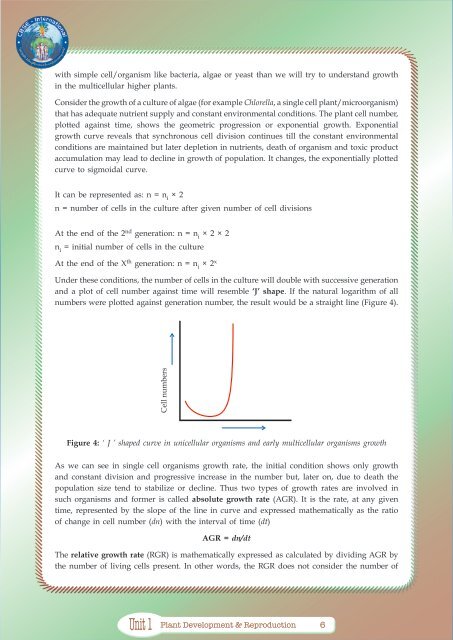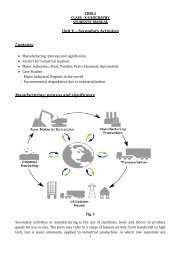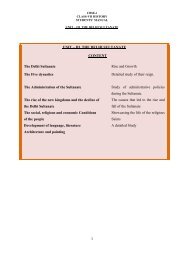PLANT DEVELOPMENT & REPRODUCTION - CBSE International
PLANT DEVELOPMENT & REPRODUCTION - CBSE International
PLANT DEVELOPMENT & REPRODUCTION - CBSE International
Create successful ePaper yourself
Turn your PDF publications into a flip-book with our unique Google optimized e-Paper software.
with simple cell/organism like bacteria, algae or yeast than we will try to understand growthin the multicellular higher plants.Consider the growth of a culture of algae (for example Chlorella, a single cell plant/microorganism)that has adequate nutrient supply and constant environmental conditions. The plant cell number,plotted against time, shows the geometric progression or exponential growth. Exponentialgrowth curve reveals that synchronous cell division continues till the constant environmentalconditions are maintained but later depletion in nutrients, death of organism and toxic productaccumulation may lead to decline in growth of population. It changes, the exponentially plottedcurve to sigmoidal curve.It can be represented as: n = n i× 2n = number of cells in the culture after given number of cell divisionsAt the end of the 2 nd generation: n = n i× 2 × 2n i= initial number of cells in the cultureAt the end of the X th generation: n = n i× 2 xUnder these conditions, the number of cells in the culture will double with successive generationand a plot of cell number against time will resemble ‘J’ shape. If the natural logarithm of allnumbers were plotted against generation number, the result would be a straight line (Figure 4).Cell numbersFigure 4: ‘ J ’ shaped curve in unicellular organisms and early multicellular organisms growthAs we can see in single cell organisms growth rate, the initial condition shows only growthand constant division and progressive increase in the number but, later on, due to death thepopulation size tend to stabilize or decline. Thus two types of growth rates are involved insuch organisms and former is called absolute growth rate (AGR). It is the rate, at any giventime, represented by the slope of the line in curve and expressed mathematically as the ratioof change in cell number (dn) with the interval of time (dt)AGR = dn/dtThe relative growth rate (RGR) is mathematically expressed as calculated by dividing AGR bythe number of living cells present. In other words, the RGR does not consider the number ofUnit 1 Plant Development & Reproduction 6








